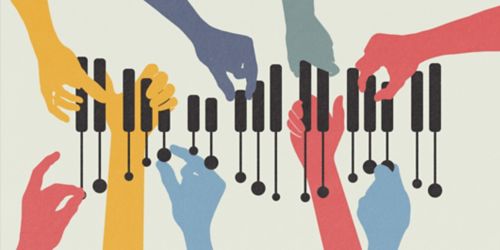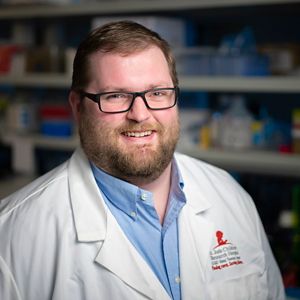St. Jude Family of Websites
Explore our cutting edge research, world-class patient care, career opportunities and more.
St. Jude Children's Research Hospital Home

- Fundraising
St. Jude Family of Websites
Explore our cutting edge research, world-class patient care, career opportunities and more.
St. Jude Children's Research Hospital Home

- Fundraising
Researchers take the fight to drug resistance up an octave

About 20% of children with ALL and twice as many adults are highly resistant to steroids, and the underlying cause of resistance is often unknown. Through gene editing technology, the search for genes involved in drug resistance have been narrowed.
Imagine the DNA sequence as the 88 keys on a piano. Just as there are many ways to alter a piano’s sound, there are multiple factors that influence gene function and cancer cell characteristics.
Here are a few.
Individual piano keys may be tuned incorrectly, just as genes can be mutated.
A foot pedal can dampen a piano’s sound, just as epigenetic processes such as attaching (tagging) methyl molecules to DNA sequences can reduce (dampen) gene expression.
Or a broken piano string will silence a key, just as deleting a gene or chromosome will silence genes and their function.
Playing a piano requires accounting for these and other factors. We take a similarly integrated approach to find genes that affect the sensitivity of cancer cells to chemotherapy drugs called glucocorticoids.
Our initial findings—14 new genes associated with acute lymphoblastic leukemia (ALL) resistance to glucocorticoid—appeared in Nature Cancer.
We are using the same novel approach to identify genes that play a role in ALL resistance to 14 other chemotherapy agents.
High stakes of cell resistance to chemotherapy
Drug resistance is a major reason treatment fails in children and adults with disseminated cancer like leukemia.
In the current study, we focused on leukemia cell resistance to glucocorticoids. These are the steroids commonly used to treat arthritis, seasonal allergies and other inflammatory conditions. For decades, these drugs have also been an essential tool in curing children and adults with ALL. But about 20% of children with ALL and twice as many adults are highly resistant to steroids. The underlying cause of resistance is often unknown.
Filling in the gaps of chemotherapy resistance
We have worked for decades to fill those gaps. In the 1990s, we focused on individual genes that contributed to chemotherapy resistance. We discovered inherited genetic differences that are now used to calculate the correct dose of thiopurine drugs used in pediatric ALL treatment.
The early 2000s and the Human Genome Project marked the start of the genomic era. The technological advances let us take an unbiased look at gene expression levels across the entire human genome rather than focus on individual genes of interest. We discovered another 121 genes that play a role in ALL drug resistance.
Subsequent studies revealed factors beyond DNA sequence changes that altered gene function and patient response to chemotherapy. The loss or gain of chromosomes can significantly affect patients’ response. So can epigenetic changes.
Identifying the genes associated with chemotherapy resistance
In response, we incorporated this knowledge into a strategy that integrates six different types of genomic information in leukemia cells to identify changes that lead to glucocorticoid resistance. We focused on gene expression; cancer-specific gene mutations, including chromosome gains and losses; certain mutations in non-coding regions of DNA and other factors that affect gene or protein expression.
Next, we used a new statistical method developed by our collaborators in the St. Jude Department of Biostatistics department to look for those features in each of the 19,750 human genes. The goal was to identify genes that had the strongest effect on drug resistance. We identified 30 of the 38 already known steroid-resistance genes and 100% of known steroid-resistance pathways in cells. We also found evidence that many more genes might contribute to the problem.
CRISPR narrows search for drug-resistant genes
To narrow the search for the most powerful drug resistance genes, we turned to gene editing technology. Using CRISPR/Cas9, we knocked out every gene in the human genome one at a time in human leukemia cells. We took the individual cells, each with a different deleted gene, combined them all and added glucocorticoids to find out when the deletion of a specific gene caused drug resistance. The results gave us 15 top drug-resistant candidates that were significant in all three of our methods, including the CRISPR screen. Fourteen of these 15 genes had no previous link to glucocorticoid resistance.
The highest priority new gene was CELSR2. We confirmed that the gene’s expression was reduced in about half of steroid-resistant leukemia patients. Low expression makes it harder for steroids to kill leukemia cells. We also discovered that when CELSR2 levels were low, ALL cells increased expression of the “anti-death” protein BCL2 in response to steroid treatment.
Drug combinations fight chemotherapy resistance
The drug venetoclax inhibits BCL2 activity. Venetoclax is already approved for treatment of other types of leukemia. In tests of human ALL cells in the lab and in mice, we showed that combining venetoclax and glucocorticoids was significantly more effective than either drug alone, especially against leukemia cells made resistant by this new mechanism of low CELSR2 expression.
The results lay the foundation for future clinical trials to test the effectiveness of the drug combination. Just as pianists strive to reduce errors and improve with each performance, we are working to fine-tune chemotherapy to reduce side effects and cure more children and adults with ALL.
The work is also a logical extension of the St. Jude-Washington University Pediatric Cancer Genome Project. The project launched in 2010 to use whole genome sequencing to advance our understanding of some of the most aggressive and least understood childhood cancers. Now we are using insights and lessons from the Pediatric Cancer Genome Project as the foundation upon which we are deploying new technology to provide additional insights into the genomic changes responsible for chemotherapy resistance.







